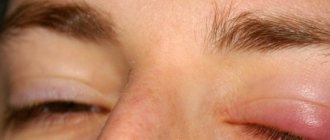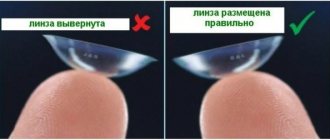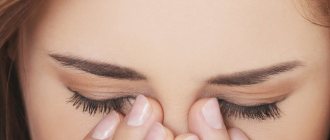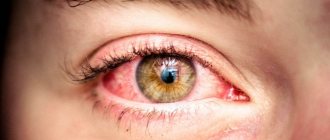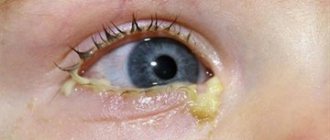People may occasionally experience tremors in their eyes.
If this is an isolated case and there are no signs of any disease, the condition does not belong to the pathological process.
If you experience frequent tremors, it is recommended to undergo a full examination by an ophthalmologist and neurologist. This sign indicates a pathology of the visual organs or a disorder of the central nervous system. Since the disease can be serious, it is recommended not to ignore the symptom or self-medicate.
From a few seconds to hours
The left or right eyelid may twitch for a few seconds, but sometimes this condition continues for several hours. It is impossible to stop a tic simply by willpower, but there are a number of exercises that will help cope with this unpleasant symptom. These exercises should be performed not at the time of an attack, but regularly, only in this case will they be effective. It should also be noted that gymnastics helps only those patients whose tics are associated with banal overexertion, fatigue and stress. If the reason why the eyelid of the right eye twitches lies in the disease, then complex therapy should be carried out.
Relaxation and exercises for the eyes
Acupuncture or massage can help with such neuralgic syndrome. You can use the following relaxation therapy : turn on quiet, melodic music, close your eyes, lie down, and imagine a pleasant landscape.
Massage that helps with nervous tics
Such relaxation will have a positive effect on the partial elimination of the tic symptom, whatever its causes.
To prevent twitching of the upper eyelid of both the right and left eye, as well as to treat this pathology, it is recommended to perform simple exercises:
- Eye movements to the right - left;
- Movements of the pupils up and down;
- Circular movements alternately in one direction and the other, frequent blinking.
Read the new article in the section: Gallstone disease: treatment without surgery and diet
Simple moves
The first thing you can try when a tic appears is the following exercises:
- Starting position standing or sitting. You need to close your eyes very tightly, while the edges of the eyelids should be as close to each other as possible. After this you can open your eyes. About 5-6 such cycles need to be completed.
- In the same position, start blinking quickly, without stopping, for 10-20 seconds. This will also help stop eyelid twitching, as it relieves tension in the eye muscles, allowing them to fully relax.
It should be recalled once again that these exercises will only help those patients who have symptoms of fatigue and overexertion. If the causes of the disease are associated with pathological processes, then you need to try other more effective methods.
Prevention
To prevent trembling in the eyes, it is recommended to adhere to the following rules:
- annual examination by an ophthalmologist to prevent the development of serious diseases;
- if the patient has ophthalmological diseases, it is recommended to undergo timely treatment and periodic diagnostics to check for various changes;
- timely treatment of systemic diseases;
- elimination of all bad habits in the form of alcoholism, drug addiction, excessive tobacco use;
- proper nutrition containing vitamins, microelements, minerals;
- playing sports to maintain normal blood circulation in all organs and tissues.
Trembling in the eyes may indicate slight fatigue or the presence of a serious illness. Therefore, it is recommended to be examined by a doctor if symptoms appear. Treatment must be carried out according to the recommendations of a specialist, since many drugs can cause adverse reactions.
Causes of tic
There are various pathological reasons for the development of a tic, in which the eyelid of the right eye twitches. In addition to the usual lack of sleep, this may be a symptom of vitamin deficiency. To cope with these deviations, it is enough to lead a correct lifestyle, get plenty of rest and sleep, and eat only healthy foods rich in vitamins and microelements. To relax the muscular system of the eye, it is very important to consume a sufficient amount of magnesium ion, which is contained in the following products:
- Bananas;
- Peas;
- Rye bread;
- Dates;
- Beans and some others.
In addition, it is necessary to reduce factors that have a depressing effect on vision and the eyes:
- Hard work at the computer;
- Watching TV (especially in the dark);
- Reading books in low light conditions.
- If the problem has become chronic
In advanced cases, a tic in which the left and right eyes twitch, this symptom may be present almost constantly. In this case, it is very important to find out the true cause of what is happening, since such a symptom can occur against the background of a serious illness. To do this, you should contact a competent ophthalmologist, who will not only conduct a diagnosis, but also select an effective treatment.
Health “Nervous tic”: What to do if your eye twitches
OLGA LUKINSKAYA
Involuntary rhythmic contractions of the muscles of the eyelid are usually referred to as “eye twitching” - and this condition is familiar to almost every person. In itself, it is not dangerous to health, but sometimes it can significantly interfere, distracting you from your work. The internet search results can be scary: conditions described as causes of tics include glaucoma, Bell's palsy and even multiple sclerosis. Let's figure out when you really need to sound the alarm and what methods help stop a twitching eye in most cases.
What is the reason and how to help yourself
Muscles contract, receiving nerve impulses, and these, in turn, are caused by the electrical activity of the brain. Sometimes this electrical activity becomes chaotic for a second - something like a “flash” occurs, causing the muscles of the eyelid to contract. In most cases, this occurs due to fatigue, high levels of stress, agitation due to excess caffeine, or excessive strain on the eyes themselves. If a tic appears, you should pay attention to the amount of coffee and tea you drink, get into a routine and improve your sleep.
Experts from the American Academy of Ophthalmology recommend reducing stress (which means getting enough sleep, meditating and being physically active) and paying attention to the condition of your eyes. Tic can be triggered by fatigue, dryness, irritation, so moisturizing drops and a timer will come to the rescue, forcing you to regularly take a few minutes off from screens. It is advisable to take care of workplace hygiene - in particular, adjust the lighting so as not to sit in twilight, but also not to irritate your eyes with too bright light.
In general, if the body uses a twitching eye to signal accumulated fatigue, you should not ignore these signals. If simple measures do not help within a few days, and your stress or anxiety levels do not decrease, you may need to deal with them more seriously - with the help of medications or non-drug methods such as psychotherapy.
If the tick gets worse
Sometimes contractions of the eyelid muscles are not a symptom of stress, but an independent disease, benign essential blepharospasm. It is usually characterized not simply by twitching of the eyelid, but by blinking with the complete closure of one or both eyes. This is a neurological disorder in which muscles constantly receive impulses that cause them to contract. Essential blepharospasm is more common in women and can seriously affect quality of life - for example, preventing you from driving a car. The cause of this disorder cannot be eliminated, but blepharospasm itself can be eliminated with botulinum toxin injections - so far this is the most effective method. In severe cases, if Botox does not help, doctors may suggest surgery.
If with essential blepharospasm the muscles of the eyelids on both sides usually contract, then with hemifacial spasm - different muscles of the face on one side. This is also a local neurological process that is not dangerous, but very unpleasant - and the first choice in treatment will be botulinum toxin injections to stop involuntary movements.
Other reasons
If you have ever been diagnosed with hyperthyroidism and, against the background of a stabilized condition, your eyelid begins to twitch, you should visit an endocrinologist; You may need to adjust your medication dosage or make some changes to your therapy. Tic can also be an undesirable effect of certain medications, in particular anticonvulsants, antipsychotics and diuretics.
As for more dangerous causes - like multiple sclerosis or amyotrophic lateral sclerosis - it is unlikely that a twitching eye can be their first sign. Such diseases manifest themselves with other, more significant symptoms and by the time the tic appears, they will most likely have already been diagnosed. So a twitching eye is not a reason to panic, even if the Internet search results say otherwise. Most likely, a tic is simply a signal from the body that it is time to take a break.
PHOTOS: Nickelodeon
Popular Misconception
Some people believe that tics are caused by one specific muscle that gets tense from time to time. However, this is not the case, because there are a huge number of muscle fibers and nerve endings in the eyelid area. In this regard, the eyelid can twitch due to any muscle. It should be noted that minor muscle tremors that occur in other areas of the body may simply not be noticed. However, a person will definitely feel even the slightest twitching in the eyelid area, which may not appear outwardly, since this area is rich in sensitive nerve endings.
If, in addition to twitching of the eyelid of your right eye, you have other symptoms of the disease (memory deterioration, increased fatigue, etc.), then you should think about proper rest for at least a few days. It is quite possible that the nervous tissue of the brain experienced overload as a result of mental work and emotional experiences. This can easily lead to a lack of oxygen (hypoxia) and B vitamins. In this case, it will be useful to visit a neurologist who will assess the degree of changes in the brain, identify risk areas, and also prescribe a high-quality multivitamin preparation.
Who gets it more often?
Hemifacial syndrome usually develops in people after 50 years of age, that is, in old age, its localization is one-sided. It usually begins with clonic short-term contractions of the orbicularis oculi muscle, then affecting other facial muscles. The onset of spasm in abnormal cases occurs from the cheek to the eye, that is, from bottom to top. With clinical convulsions of the facial muscles of a stable type, their tonic contraction gradually occurs. This is noticeable by the fact that the organ of vision has stopped twitching and is constantly in a state of spasm, which makes vision impossible. The long-term nature of the disease causes paresis of the facial muscles.
Why does the eyelid twitch?
When the problem is in the spine
Twitching of the eyelid can also occur with diseases of the spine. In this case, the nerve fibers that contain motor neurons directed to a specific muscle group are compressed. In this case, it is also very important to visit a neurologist, since only he is able to identify problems and prescribe a full examination of the cervical spine, including an MRI.
In this case, drug therapy comes to the rescue, but quite often it is possible to cope without pills. Just move regularly enough, not necessarily in the gym. You can just walk more and not sit at the computer. It is very useful for diseases of the spine to visit a massage therapist and undergo several sessions of manual therapy.
If twitching of the eyelid of the right eye persists for several weeks, and the discomfort gradually spreads to most of the face, then this indicates a serious neurological deficit. Sometimes the cause lies in ordinary vegetative-vascular dystonia, but often it is associated with a more fatal problem. In order not to worry in advance, you must undergo a full examination by a neurologist, who will be able to clarify the diagnosis and prescribe the correct treatment.
Which doctor should I consult?
The upper eyelid twitches rarely and spontaneously - this is not a cause for concern. But, if hyperkinesis appears constantly and the “attack” lasts for several hours, you need to contact a neurologist. It’s the same when the eye doesn’t just twitch, but this process is accompanied by pain or even just discomfort.
Having studied the patient’s medical history and the nature of the manifestation of hyperkinesis, the neurologist identifies its most likely causes. To confirm the diagnosis and develop a treatment regimen, consultations with other specialists are required - ophthalmologist, cardiologist, endocrinologist.
Drug treatment
Therapy with medication is usually used in situations where specific help is already needed and other methods have not helped. Before prescribing certain medications, the general clinical picture is determined and it is determined whether a nervous tic has appeared as a result of diseases. Then, general treatment for the diagnosed disease, nootropics and a mild sedative are usually prescribed, which can strengthen and stabilize the central nervous system. Such remedies are “Glycine”, “Piracetam”, “Novopassit”, tinctures of hawthorn, peony, valerian, motherwort.
In particularly severe cases, specialists may prescribe botulinum toxin injections to the patient. Thanks to them, the muscle fibers that involve the lower eyelid in the process of involuntary movement are well relaxed.
Many medications have their own side effects and contraindications. If used incorrectly, they can worsen the patient's condition and increase symptoms. That is why before use you need to read the instructions and consult a specialist.
Central nervous system disorder
Nervous tics that last seven days or a month may indicate a systemic type of central nervous system disorder. Such disorders include Tourette's syndrome, that is, a genetic pathology that manifests itself in young children. In this case, the little patient's eye twitches and other motor, mechanical and vocal tics are noted. Gradually developing nervous and muscular systems reduce the degree of their manifestation, and by adolescence they almost disappear.
We continue to understand why the eyelid twitches.
Blepharospasm
A condition that is more dangerous if the eye twitches is called blepharospasm. It refers to the uncontrolled and involuntary contraction of the orbicularis muscle surrounding the eye. The muscle above and below the eye twitches, causing the eyelids to close in a spasmodic manner. Blepharospasm is accompanied by swelling of the eyelids, excessive photosensitivity, lacrimation, and dry vision. At the beginning, attacks of blepharospasm end quite quickly, but as the main disease worsens, they become longer and can eventually last the whole day. On each side of the face there are branches of the trigeminal nerve, and therefore when it is inflamed, for example, when a person’s right eye twitches, severe numbness, tremors and pain in the corresponding cheek are possible.
Why does the eyelid twitch in this case?
Determining the cause of blepharospasm is required to determine how to treat this condition. It can be called:
- uveitis;
- inflammation of the eyelids (blepharitis);
- trichiasis;
- microtraumas and scratches of the cornea;
- photosensitivity;
- decreased tear production (dry outer membrane);
- glaucoma at the stage of optic nerve defect;
- internal entropion of the eyelid, or entropion.
Therapeutic techniques
Therapeutic techniques are based on normalizing lifestyle. It includes:
- doing exercises;
- avoiding stress;
- normalizing activity during the working day;
- normal rest;
- eliminating a number of foods from the diet that can cause disruption or stimulate the nervous system;
- normalization of diet.
Normalizing human activity during daylight hours means reducing stress for people with high activity and increasing it for those who lead a sedentary lifestyle. At the same time, you need to normalize your rest regime. In this case, we mean both sleep and leisure, namely the time that a person should allocate for his needs every day. Often, even with a normal amount of sleep, people suffer from nervous tics because they cannot take time for themselves: watch a movie, go to the spa or go to the hairdresser.
Many people have difficulty avoiding stress, since it is mainly associated with family or work. Therefore, it is especially important to gradually begin to change your own life. In such situations, in extreme cases, if it is not possible to change the lifestyle, specialists prescribe medicinal courses of a sedative or sedative type. It is especially important to pay attention to your diet. In this situation, we mean a deficiency of certain macro- and microelements, which are necessary not only for the body in general, but also for the central nervous system in particular. The nervous system is most in need of various minerals and B vitamins. Vitamins E and A are also important. Vitamin C strengthens and improves the circulatory system, and this, in turn, allows the nervous tissue to be fully nourished. Products such as strong black tea, coffee, energy drinks and alcohol significantly overload the nervous system. If these drinks are taken for a long time and in large quantities, the activity of the central nervous system is often disrupted, which leads to the appearance of various negative symptoms. In addition, they have a negative impact on overall health, and therefore can greatly worsen the patient’s condition.



